20 recipes to upgrade your May bank holiday barbecue
From chimichurri steaks to coal-roasted aubergines and spicy salmon skewers with a red pepper sauce on the side, Hannah Twiggs rounds up 20 summer-ready recipes to see you through the May bank holiday in style

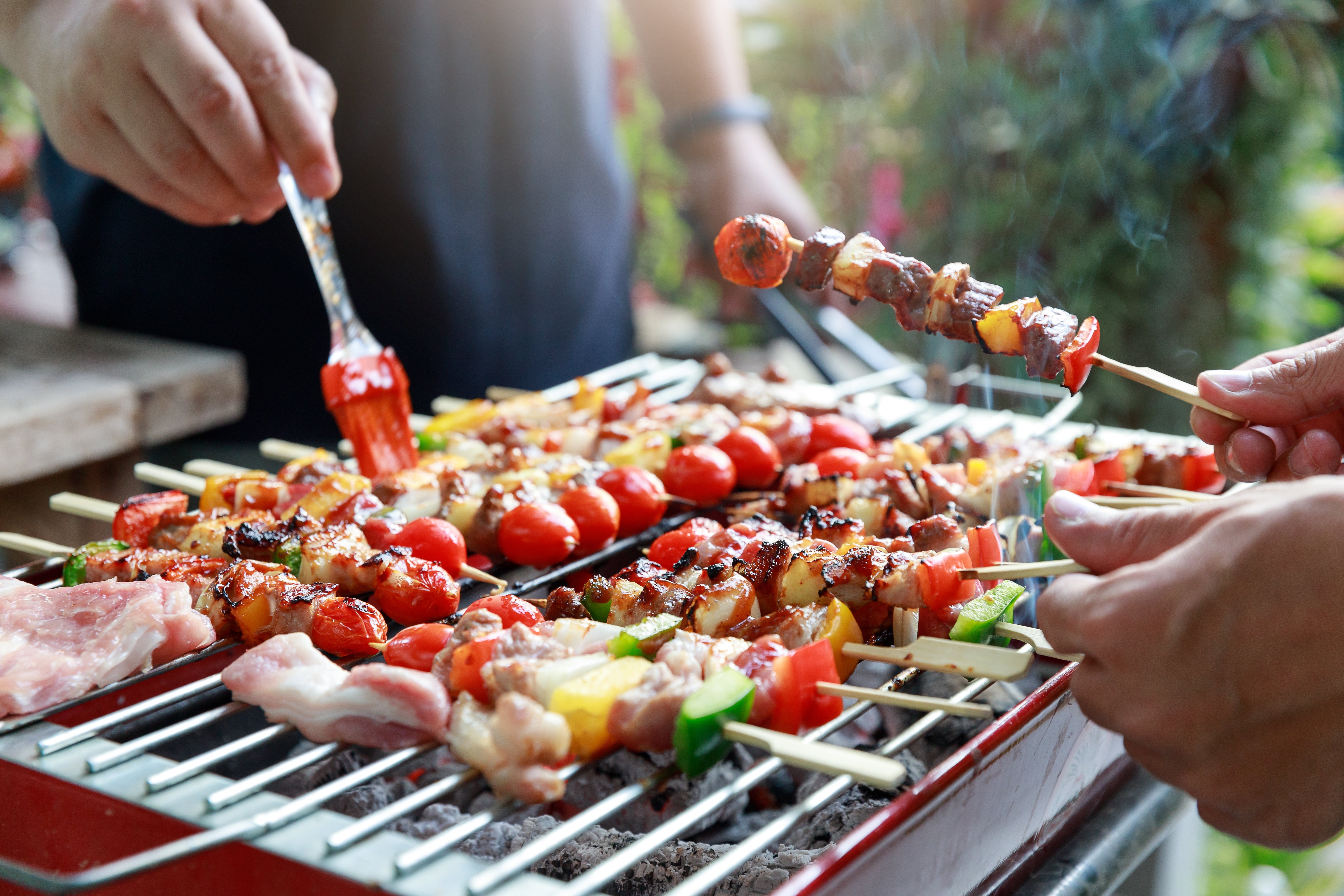
Britain’s relationship with barbecues is a curious thing. We treat the slightest suggestion of sunshine like a royal decree to sprint to the nearest supermarket, clear it of sausages and do questionable things to meat over gas or a few sorry coals. But this bank holiday weekend – and the long, lazy summer ahead – deserves better.
Here, then, is a collection of recipes to make you the person everyone wants to befriend at the barbecue.
From the holy grail that is chimichurri to smoky aubergine buttered in red miso, spicy salmon skewers and a cheesecake so good it might just steal the show from your steaks, these are dishes designed to deliver big flavours with minimum faff.
There’s still steak and fire and a bit of bravado, of course.
But there’s also poached peaches and burrata, grilled lamb with horseradish cream and the sort of niçoise salad that doesn’t feel like a punishment. Because if you’re going to worship at the altar of charred meat and sun-drenched afternoons, you may as well do it properly.
Kofta spiced slow-grilled lamb ribs with parsley zhoug
.jpeg)
Recipe by: Drew Snaith, chef at SESTA
Serves: 4 alongside a few sides
Ingredients for the lamb ribs:
1 x 1.2kg lamb belly, bone in
150g rock salt
45g light brown sugar
25g fennel seeds
30g coriander seed
15g cumin seed
20g black pepper
30g sumac
15g Turkish pepper flakes
1 lemon, cut into quarters
1 bulb garlic cut in half
1 small bundle of lemon or regular thyme
100g runny honey
25g date syrup/molasses (black treacle would also work great here)
1L pomace olive oil
Flakey salt to taste
Method for the lamb ribs:
1. First you need to cure the lamb belly, blend together the spices and then combine with the rock salt and sugar. Rub this all over the lamb and leave in a tray in your fridge overnight. In the morning, rinse off the cure in running cold water and pat dry with a clean cloth. Preheat your oven to 150C and place the lamb belly in a deep roasting tray and cover with the olive oil, add in the lemon, garlic and thyme and place in the oven for 50-60 minutes, until the lamb is just tender to a small knife. Remove from the oven and allow to cool.
2. When you’re ready to eat, remove the lamb from its confit oil and pat dry with a clean cloth.
3. You want to have a very gentle fire for this, slow grilling is the aim on this.
4. Grill the lamb skin side down first and build up a nice golden crust. Turn the lamb and pull to the side of the fire, put the lid over your BBQ and let the lamb come up for 10 minutes, this would be a great point to add some wood chips to the fire if you have them and to let them smoke in this time.
5. Meanwhile mix the honey and date syrup.
6. Remove the lid of the BBQ and baste the lamb with the syrup mix. Turn over and move back to directly over the fire. Keep flipping and basting until you have a lovely glazed belly.
7. Allow to rest covered in foil for 10 minutes, carve up into ribs and serve.
Ingredients for the parsley zhoug:
150g parsley
50g coriander
2 cloves garlic, peeled
350ml extra virgin olive oil
3g ground green cardamom
5g ground cumin
3g toasted caraway seeds
2g black pepper
8g fine salt
Zest and juice of 2 lemons
2 green chillies, green stem removed
5 large dashes green Tabasco
Method for the parsley zhoug:
1. Roughly chop the herbs and place into a food processor along with the salt, garlic, lemon and chillies (you can remove the seeds if you like, but I prefer it to be fairly spicy). Blend until starting to get quite fine and then stream in the olive oil. When nice and smooth, add in the remaining ingredients and adjust the seasoning to your taste if needed.
2. Ideally make this a few hours before serving to let the flavours develop.
Grilled potatoes with miso ranch dip
Charred and crispy on the outside, fluffy in the middle, these grilled potatoes come with a miso ranch dip that’s creamy, salty and just the right side of addictive.
Recipe by: Drew Snaith, chef at SESTA
Serves: 4 as a side or for a table snack
Ingredients for the grilled potatoes:
800g salad potatoes (such as maris peer, desiree or pink fir) cut into bite size pieces
150ml good quality rapeseed oil
16g table salt
10g chopped marjoram or thyme
2 cloves garlic, crushed
A little more good rapeseed oil
Flakey sea salt to taste
Method for the grilled potatoes:
1. Place all ingredients except the flakey salt in a saucepan and cover with cold water, place on a lid, and bring to a gentle simmer for 8 minutes, they should be slightly al dente, drain and allow to cool on a tray.
2. Prelight your fire and allow it to burn down to white hot coals.
3. Dress the potatoes with a little more rapeseed oil and the flakey salt, and lay out on a grill above your fire. Keep turning every minute or so until they are fully cooked through and nicely charred.
4. Serve in a big bowl dressed with a squeeze of lemon and whatever soft herbs take your fancy.
Ingredients for the miso ranch:
150g mayonnaise
150g creme fraiche
80g finely grated coolea cheese (parmesan or pecorino also work well)
15g chives
10g dill
5g black pepper, cracked
4g salt
50g yellow miso
8g onion powder
1 clove garlic
Method for the miso ranch:
1. Finely chop the garlic, chives and dill and place in a suitable bowl with the miso, onion powder, salt and pepper, mix well until fully smooth then beat in the cheese.
2. Now add the mayo and creme fraiche and stir through to combine. Store in the fridge for 2 hours before serving to allow it to thicken.
’Nduja Scotch olives with aioli
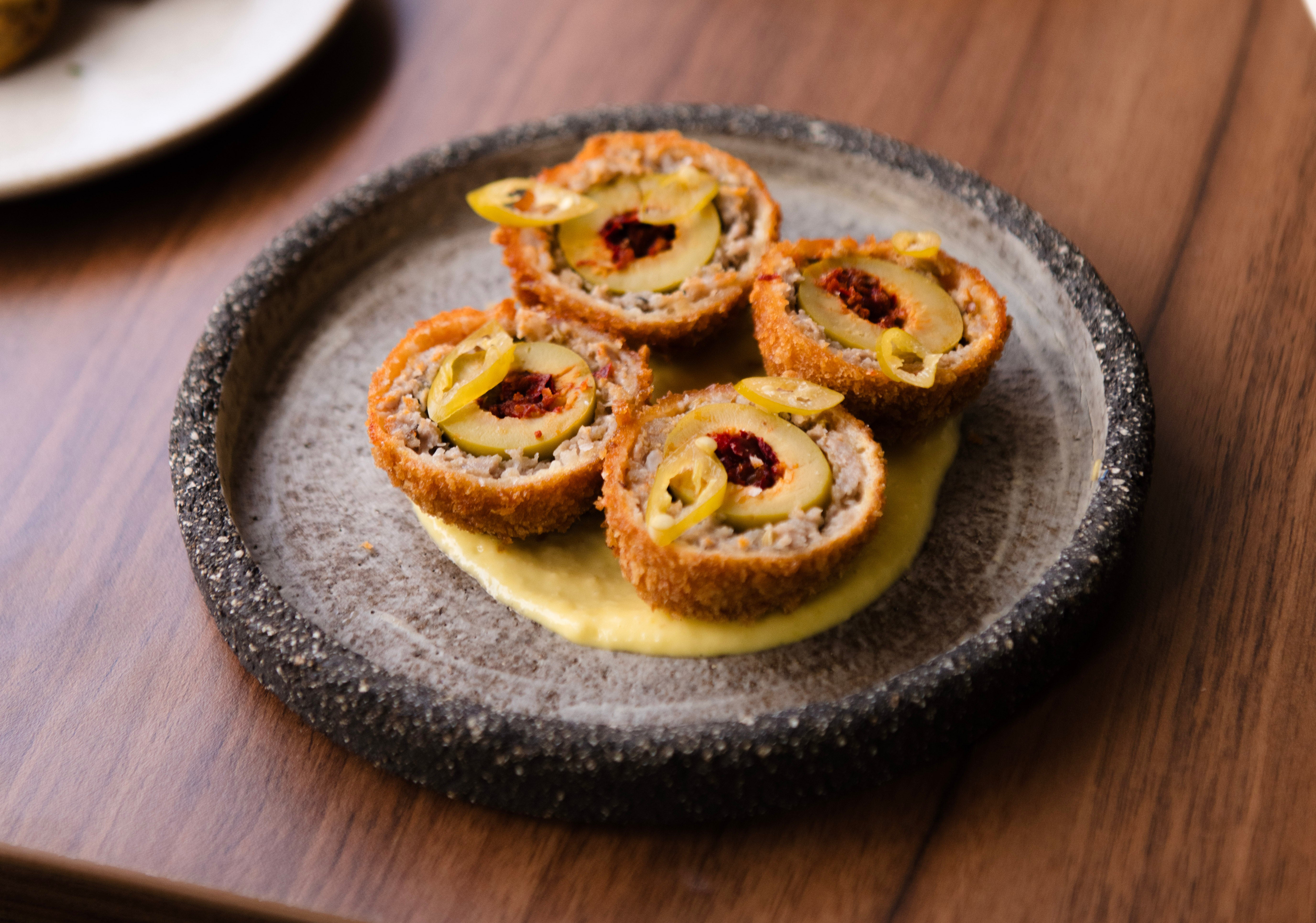
Scotch eggs, but reimagined for grown-ups – these fiery little flavour bombs wrap nduja-stuffed olives in sausage meat and crisp breadcrumbs, perfect for passing round with drinks or piling high on a platter.
Recipe by: Drew Snaith, chef at SESTA
Makes: 10
Ingredients for the Scotch olives:
400g sausage meat
10 whole olives (good quality like perilla/nocellara)
50g Nduja
Two beaten eggs
50ml milk
120g plain flour
220g panko breadcrumbs
Vegetable/rapeseed oil
Method for the Scotch olives:
1. First, take your nduja and beat in a small bowl so it becomes workable. Carefully stuff the nduja inside the olives. Place in freezer and chill for 15 minutes.
2. Meanwhile, weigh out 10x40g patties of sausage meat. Once done, take the olives out of freezer.
3. Place sausage patty in palm of hand and squish flat – use a little cold water on fingers to avoid sticking. Place the olive in the centre of the patty and flip so the sausage meat falls around the olive and closes. Place all of the balls onto a tray lined with parchment paper and place in the freezer for 15 minutes.
4. Once nice and chilled, dip hands into cold water and use to roll the balls until smooth.
5. Now set up your breadcrumbing station. Line up a bowl of flour, a bowl of beaten eggs and panko breadcrumbs. Put the sausage meat ball into the flour, roll until covered and tap off excess flour. Do the same in the eggs and then panko breadcrumbs. Place back in the fridge for half an hour.
6. Set up a deep-frying station or a suitable pan with vegetable/rapeseed oil. Using a slotted spoon, gently place the balls into the hot oil and fry for two and a half minutes. Remove from oil with a slotted spoon and drain on a plate or tray lined with kitchen paper.
7. Allow to rest for a minute and a half and then slice in half or enjoy whole.
Ingredients for the aioli:
80g peeled garlic cloves
500ml extra virgin olive oil
Juice of two lemons
Zest of one lemon
30g dijon mustard
30g English mustard
Two pinches of coarse salt
One pinch of MSG
Method for the aioli:
1. In a pestle and mortar, add the garlic, salt, MSG and mustards. Smash into a smooth paste. Transfer to a suitable mixing bowl.
2. Using a whisk, steadily pour the oil into the garlic paste mixture while mixing vigorously.
3. Keep going until all of the oil has been added and has a thick mayonnaise-like texture.
4. Store in the fridge until required and use within three days
5. Any excess can be used with salads, boiled potatoes, steamed vegetables or added to a sandwich.
Chicken and pistachio shish
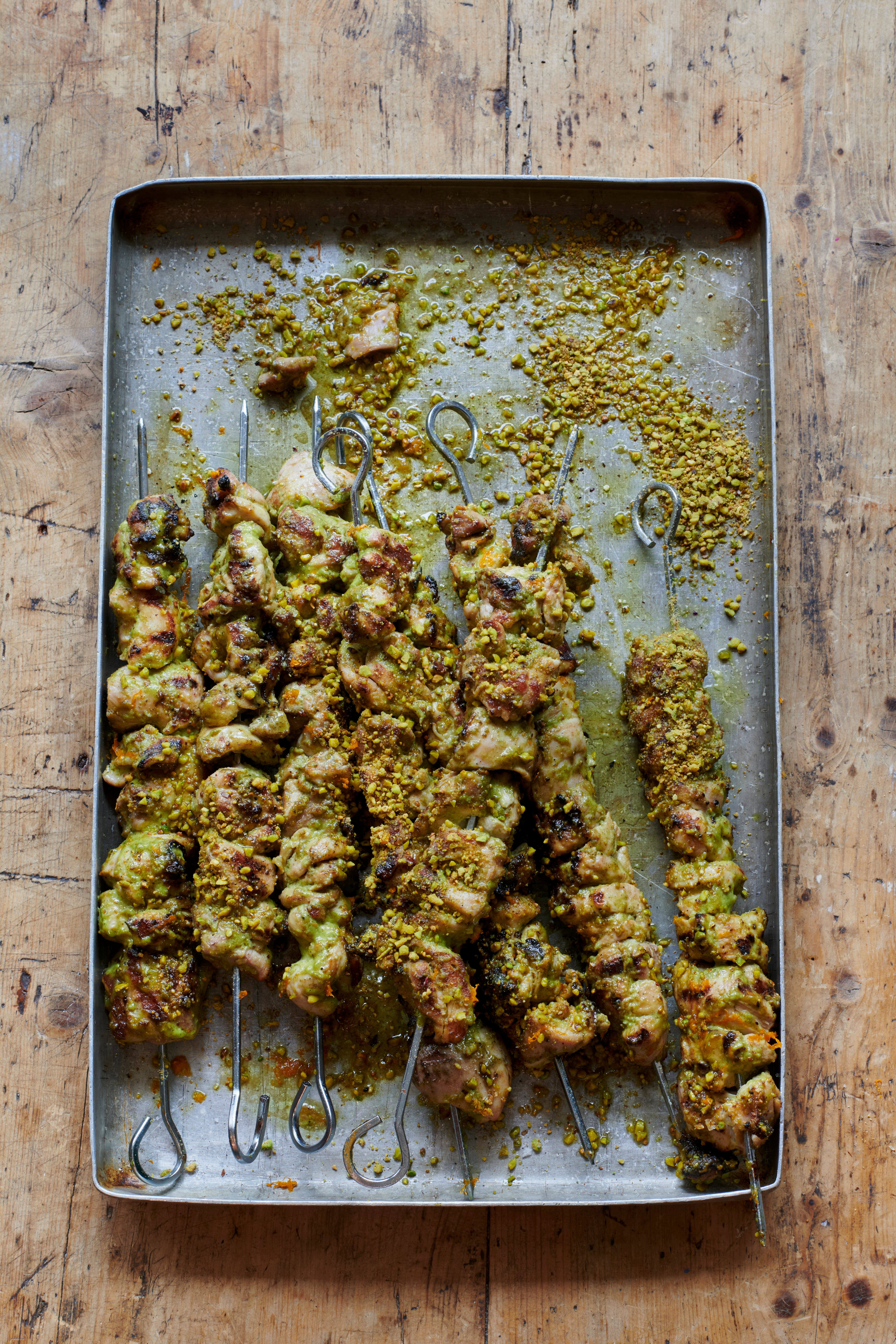
Despite this seemingly lengthy method, this celebrated bestseller at the restaurant is straightforward and uncomplicated to prepare. Enjoy it solo or as part of a spread. It is perfectly paired with cold beer, crisp verdejo or lively vinho verde. This is a great recipe to barbecue – try the master of gentle cooking, occasional basting and skewer rotation to create flavour layers, infuse smoky nuances, achieve a perfect crust and retain the tenderness and juiciness of your chicken. You will need eight skewers.
Recipe by: James Walters, chef-founder at Arabica
Makes: 8 skewers
Ingredients:
1.2kg skinless chicken thigh fillets, cut into 2-3 cm cubes
Extra virgin olive oil
Pinch of Maldon sea salt
30g unsalted pistachios, finely chopped
Zest ½ orange
For the marinade:
1-2 long green chillies deseeded
1 garlic clove
30g flat parsley
½-¾ lemon
2 tsp ground cardamom
¼ tsp freshly milled black pepper
3½ tsp caster sugar
1½ tsp Maldon sea salt
150g sunflower oil
120g Greek yoghurt
Method:
Prepare and marinate the chicken:
1. Place all the marinade ingredients (except for the yoghurt) in a food processor or tall beaker. Blend with the processor or a stick blender, until you achieve a fine, vibrant, green paste.
2. Whisk the yoghurt gently in a large bowl, then gradually fold in the green paste with a tablespoon at a time. Be careful not to overmix; maintain a thick, creamy texture. Remove one-third of the marinade and set aside for basting.
3. Add the chicken thigh pieces to the bowl with the marinade and turn to ensure they are thoroughly coated. Leave to marinate in the fridge for at least 2 hours, preferably overnight.
Cook the shish:
4. About an hour before cooking, take the chicken out of the fridge to bring it up to room temperature; this helps to ensure uniform cooking and preserves the juiciness of the chicken thighs. If you’re using wooden skewers, soak them in cold water to prevent burning.
5. Thread the marinated chicken onto 8 skewers.
6. For optimal results, use high-quality lumpwood charcoal and barbecue the shish. Alternatively, if using the oven grill, preheat it to the highest setting. Line a baking tray with foil and place the skewers on top. Grill, flip and baste the shish until fully cooked. For the precision-seekers, having a probe thermometer on is a gamechanger. The chicken is cooked when the internal temperature hits 74C. Otherwise, a gentle cut into the chicken will do – clear juices are your green light.
Plating up:
7. Drizzle the skewers with olive oil, add a pinch of salt, generously dust with the pistachios and finish with a little finely zested orange.
Spiced chicken wings with herbs
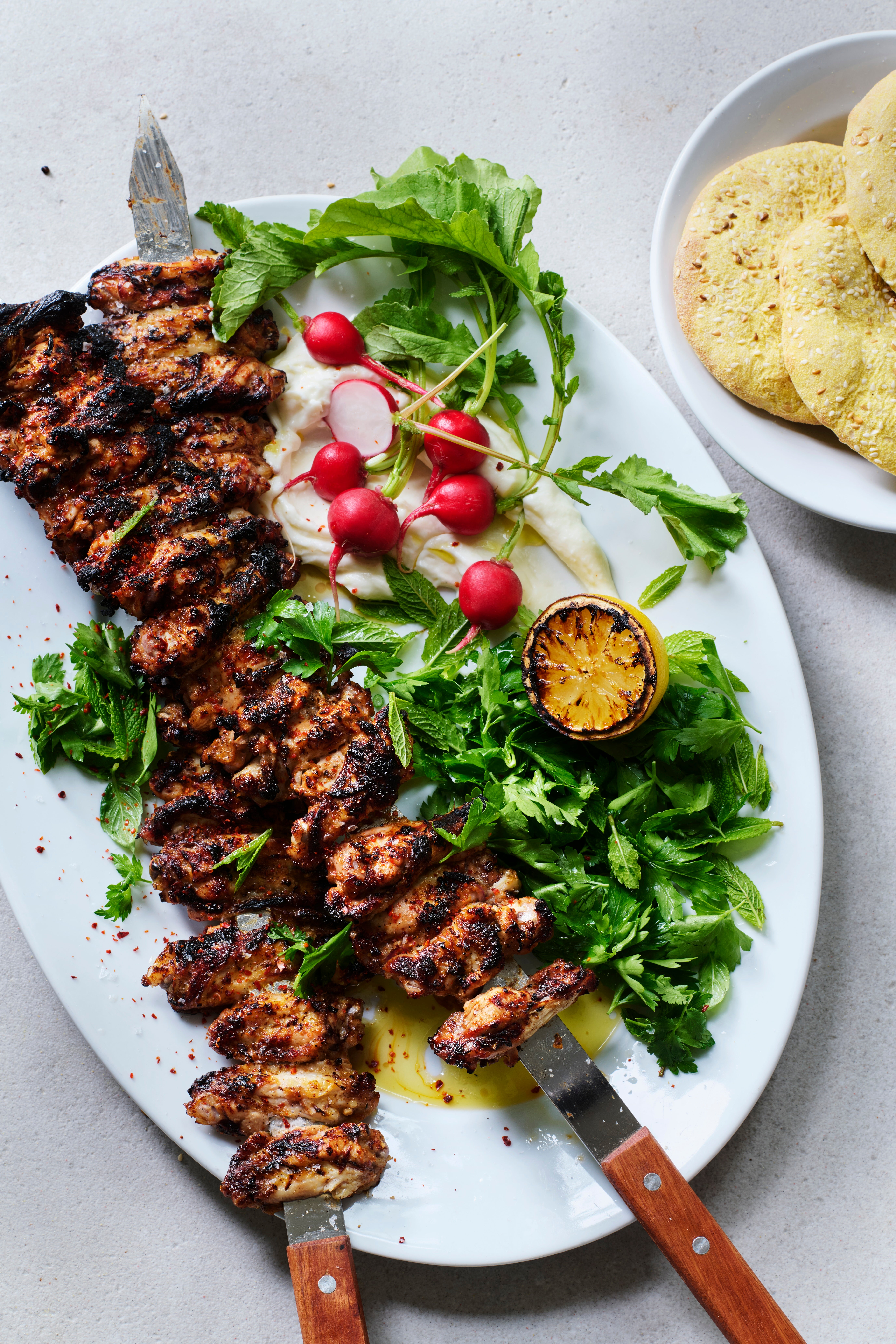
A zesty yoghurt marinade bursting with citrus, garlic, aromatic spices and Mediterranean herbs – perfect for chicken. My favourite cuts for this marinade? Wings or bone-in, skin-on thighs – or even a whole chicken with its crowd-pleasing mix of white and brown meat. You’ll need some flat, wide, metal skewers if you want to barbecue the chicken.
Recipe by: James Walters, chef-founder at Arabica
Serves: 4-6
Ingredients:
1.6kg chicken wings
For the 7-spice marinade:
1 lemon, finely sliced
1 red onion, finely sliced
5 garlic cloves, finely minced
20g tomato puree
100g Greek yoghurt
100g extra virgin olive oil
3 tbsp red wine vinegar
2 ½ tsp 7 spice
1 tsp ground mahlab (a versatile spice made from ground, dried cherry pits. While grinding fresh whole fried cherries yields a more intense flavour, it is more commonly found pre-ground in small bags)
3 tsp pul biber (red pepper flakes)
3 tsp dried oregano
8 sprigs of marjoram, leaves picked and finely chopped
4 tsp Maldon sea salt
Finishing touches:
½ lemon
Extra virgin olive oil
Pinch Maldon sea salt
Pinch of pul biber
Handful of parsley leaves
Handful of coriander leaves
Handful of mint leaves
Method:
Prepare the chicken:
1. Start by trimming off the wine tips at the joint and discarding them. Cut through the joint between the drummette and wingette to separate each wing into two pieces.
Make the marinade:
2. In a dish large enough to hold all of the chicken, combine the lemon and red onion, squeezing them between your hands for 1-2 minutes to break them down and extract the pungent water from the onion, as well as the oils and juices from the lemon. Add all the remaining marinade ingredients and whisk to blend.
3. Add the chicken to the bowl and rub all over to coat in the marinade. Cover the bowl with cling film and leave the wings to marinate in the fridge for at least four hours, preferably overnight.
Cook the chicken:
4. Take the chicken out of the fridge 1 hour before cooking to bring it to room temperature. Fire up the barbeque, then wait for the flames to die down and the glowing coals to be covered in white ash. Or, preheat the oven to 220C.
5. Thread the drummettes and wingettes onto separate metal skewers, if barbecuing, or place all the chicken in a roasting tin, if cooking in the oven.
6. Cook the wings on the barbecue for about 15-20 minutes (the wingettes will cook faster than the drumettes), checking and turning regularly until the skin crisps and develops some charred edges. Place the lemon half on the grill, cut side down, and grill for 5 minutes. If cooking indoors, place the chicken in the preheated oven and cook for 30-40 minutes, turning halfway. Cooking times will vary depending on the cut of chicken and your chosen cooking method – the key indicator is achieving an internal temperature of 74C with a probe thermometer, or the juices running clear when you cut into the thickest part of the chicken.
Plating up:
7. Transfer the chicken to a serving plate, squeeze the frilled lemon over the top, drizzle with olive oil and season with salt and pul biber. Scatter over the fresh herbs and serve with some garlic sauce (recipe below), fermented hot sauce (recipe below), radishes and a stack of flat breads, or a bowl of crisp, green salad.
Ingredients for the garlic sauce:
1 garlic bulb, cloves peeled
1 egg
Juice of ½ lemon
300g sunflower oil
1 tbsp Maldon salt
Method for the garlic sauce:
1. Place all the ingredients in a tall beaker. Place the stick blender in the beaker, ensuring that all the garlic cloves are submerged and trapped beneath the blades. Push the blender as far down into the beaker as possible, while still ensuring the cloves are beneath the blades.
2. Blend the ingredients without moving the blender until a smooth puree is formed and the bottom of the mixture changes to a whitish colour with some residual vegetable oil on the surface. Gradually raise the blender, allowing the remaining mixture to emulsify without separating. Once you reach the top, you’ll have a creamy, mayonnaise-like consistency. The sauce will keep for up to four days in an air-tight container.
Ingredients for the fermented hot sauce:
15g crushed chilli flakes
65g double-concentrated tomato paste
15g Maldon salt
300g boiling water
Method for the fermented hot sauce:
1. Combine the crushed hot chilli flakes, tomato paste and salt in a metal mixing bowl. Pour the boiling water over the mixture and stir the ingredients then leave to cool. Blend the cooled mixture using a stick blender, then transfer to a sterilised jar or container.
2. After preparing the hot sauce, it can be used immediately or stored in a cool, dry place away from direct sunlight. Allow it to ferment for 1-2 weeks, and carefully open the jar every few days to release any built-up gases. Once fermented, store the hot sauce in the fridge and enjoy it within 3 months.
Watermelon and feta salad
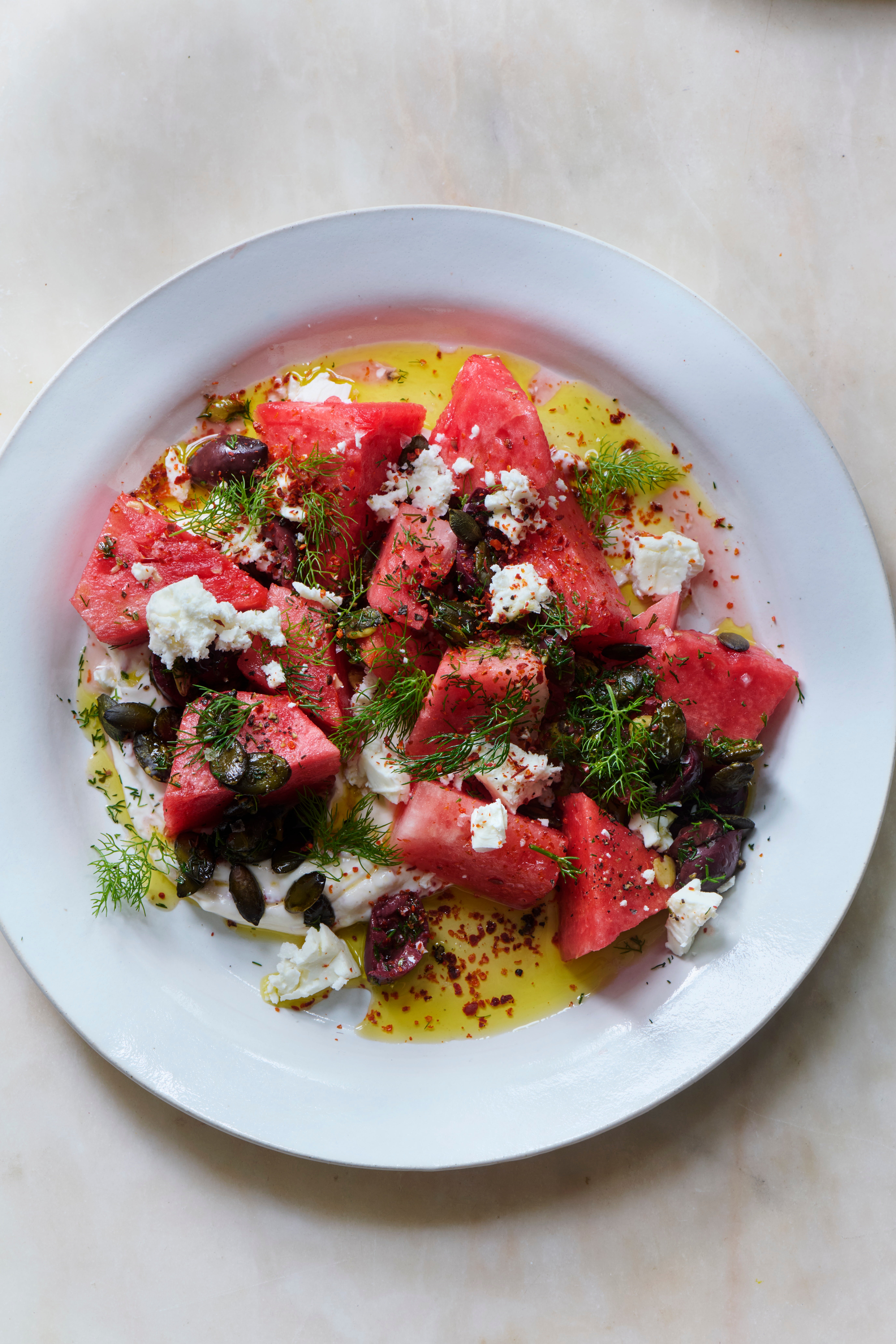
Watermelon and feta are always on standby in my fridge during long sunny days. When selecting watermelon, choose a wedge from a greengrocer if you can, instead of a small whole watermelon from the supermarket. Larger watermelons are typically sweeter, avoid prepared chunks or slices.
Recipe by: James Walters, chef-founder at Arabica
Serves: 4
Ingredients:
500g watermelon flesh, cut into irregular bite sized chunks
50g kalamata olives, pitted and torn
30g pumpkin seeds, toasted
Juice of ½ lemon
2 tbsp extra virgin olive oil
8 sprigs of dill, roughly chopped
¼ tsp dried oregano
40g feta cheese, crumbled
¼ tsp pul biber
For the whipped feta:
70g feta cheese
100g Greek yoghurt
½ mild chilli, deseeded
Method:
Whip the feta:
1. In a tall beaker, combine the feta cheese, 20g yoghurt and red chilli. Blend thoroughly using a stick blender at maximum speed, then fold through the remaining 80g yoghurt with a spatula. Chill in the fridge while you prepare the salad.
Make the salad:
2. In a large mixing bowl, combine the watermelon, olives, half the pumpkin seeds, the lemon juice, 1 tablespoon of olive oil, three-quarters of the dill and the oregano. Toss everything together gently.
Plating up:
3. Spoon the whipped feta onto a serving plate and smear it across the surface with the back of a spoon. Top with the watermelon salad, then crumble over the remaining feta. Garnish with the remaining olive oil, dill fronds, and pumpkin seeds, finish with pul biber.
Grilled halloumi and black honey
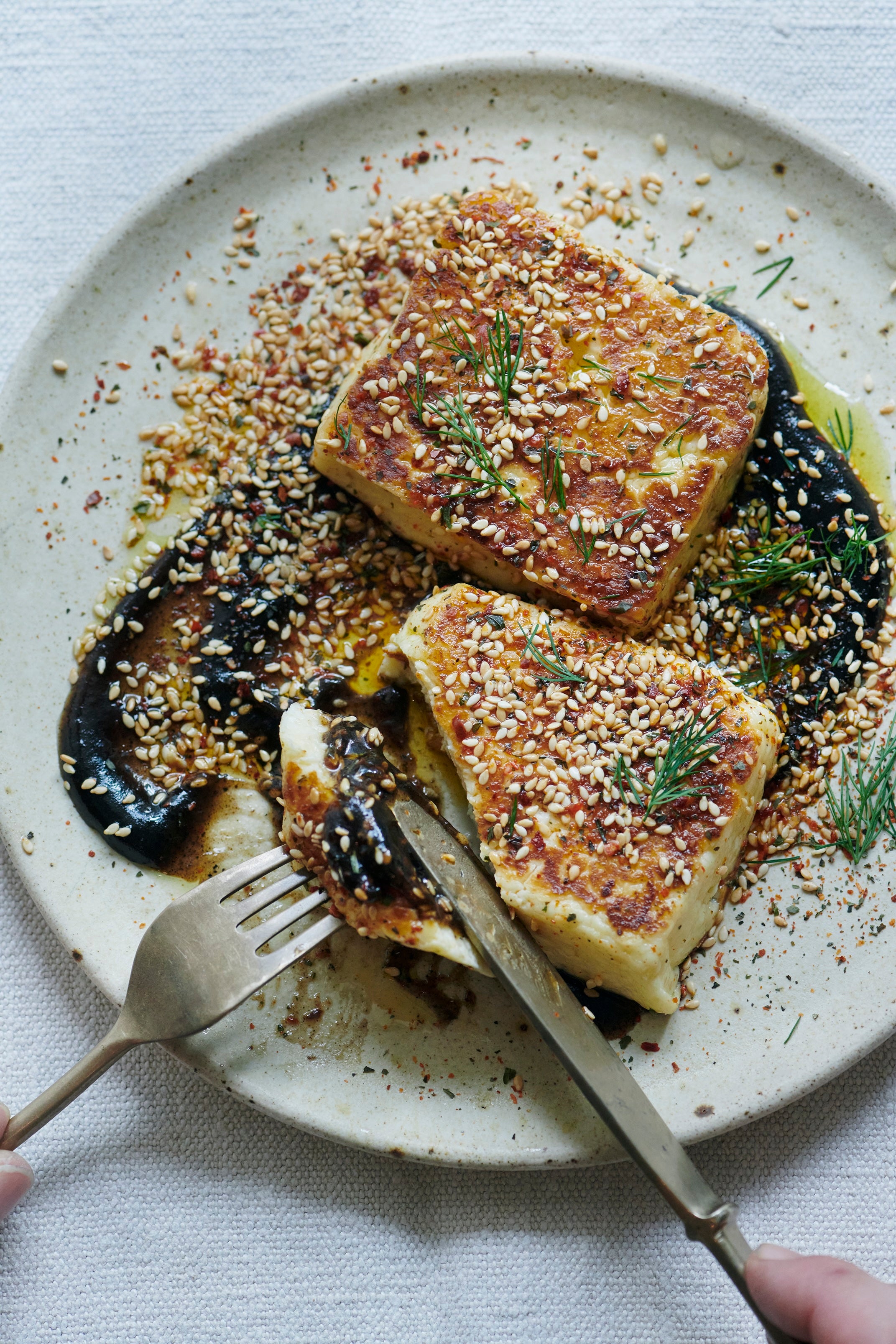
As my five-year-old often reminds me, “Sharing is caring”. So, I’m sharing one of our bestsellers. Here, the smoky sweetness of black honey meets the mellow saltiness of halloumi, and is crowned with crunchy toasted sesame, Turkish dried mint and fruity pul biber. The secret behind the zero-waste black honey lies in its ingenious repurposing of the surplus skins left over from making smoked aubergine dishes. Often overlooked and discarded, these charred skins impart a rich, unique and smokey flavour to the honey. Look out for authentic halloumi cheese made from a mix of goat’s and sheep’s milk, and get ahead by making the black honey in advance.
Recipe by: James Walters, chef-founder at Arabica
Serves: 4
Ingredients:
1 x 250g block halloumi cheese
2 tbsp extra virgin olive oil
For the black honey:
100g burnt aubergine skins
100g runny honey
Pinch Maldon sea salt
¼ tsp orange blossom water to taste
For the toasted sesame mix:
2 tbsp sesame seeds
¼ tsp pul biber
¼ tsp Turkish dried mint
Finishing touches:
1 tbsp extra virgin olive oil
Juice from ¼ lemon
A few dill fronds
Method:
Char the aubergine skins:
1. Preheat the grill to its highest setting.
2. Prick two aubergines with a sharp knife.
3. Position the aubergines approximately 5cm below the grill elements and start to blacken them. Turn the aubergines regularly until the skin is fully charred and they are soft to touch and collapsing (this can also be done over hot coals on the BBQ or a gas hob).
4. Remove the filling and keep the skins for the black honey.
Make the black honey:
5. Combine the aubergine skins with 100g water in a mini food processor. Blend on high until you achieve a puree. Pass the mixture through a fine sieve into a small heavy-based saucepan.
6. Add the honey and pinch of salt and bring to the boil over a medium heat. Reduce the heat and simmer for 2-3 minutes.
7. Remove from the heat, stir through the orange blossom water and leave to cool. The honey will keep in the fridge for up to one month.
Toast the seeds and make the mix:
8. Toast the sesame seeds in a dry frying pan over a medium heat, swirling constantly for 5-6 minutes, or until light golden brown.
9. Remove from the heat and set aside to cool.
10. Mix the sesame seeds with the pul biber and dried mint.
Fry the halloumi:
11. Cut the block of halloumi in half, following the natural fold of the cheese
12. Heat the 2 tbsps of olive oil in a non-stick frying pan over a medium-high heat. Add the cheese and cook for 3-4 minutes without moving, to release some liquid. When the liquid has evaporated, a golden brown crust will form quickly. Flip the halloumi with a spatula and fry the other side for 2-3 minutes, until crispy. The inside should remain soft and squidgy to touch.
Plating up:
13. Smear 2 heaped tbsps of the black honey across a plate with the back of a spoon. Place the pan-fried halloumi on top, drizzle with olive oil, a squeeze of lemon, a generous scattering of the toasted sesame mix and a few dill fronds. Serve immediately.
Three delicious ways to complement your barbecue steaks
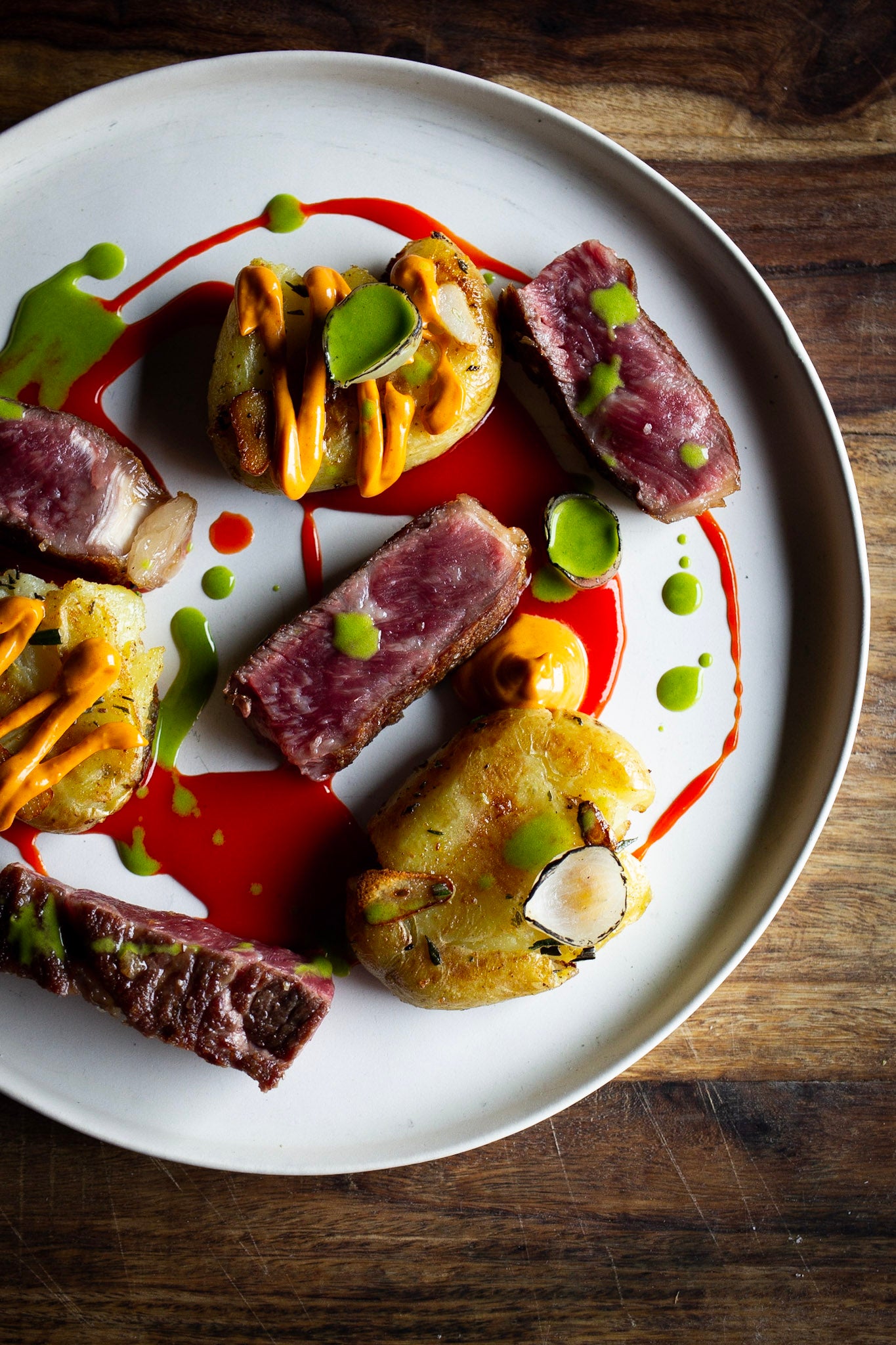
Chimichurri
Considered the holy grail in South America, chimichurri adds both complex flavour and a subtle spice to your favourite cut of steak from the barbecue.
Recipe by: Francisco Martinez, executive chef at Fazenda
Serves: 4
Ingredients:
50g parsley
10g thyme
10g rosemary
10g oregano
½ red chilli
½ white onion
1 tbsp of salt
½ tbsp of black pepper
100ml white vinegar
30ml extra virgin olive oil
50ml sunflower oil
50ml water
Method:
You just need a chopping board and a little bowl. Simply finely chop all of your ingredients, and then mix all ingredients together and let them do the magic themselves.
Tip: Chimichurri tastes better when it’s cold!
Red pepper puree
The perfect summer drizzle for your barbecue, the sweetness of the piquillo peppers in this puree lends it as a delicious partner for steaks, salad and potatoes alike.
Recipe by: Francisco Martinez, executive chef at Fazenda
Serves: 4
Ingredients:
200g roasted piquillo peppers
30g olive oil
3g salt
2g black pepper
Method:
Add all of your ingredients into a blender and blend for roughly a minute. Once this is done, you can pass the mixture through a sieve if you’d prefer it to be smoother.
Piquillo pepper aioli
No al-fresco dining is complete without aioli, especially piquillo pepper aioli. Using only a handful of ingredients, this recipe is simple with marvellous results.
Serves: 4
Ingredients:
100ml olive oil
3g salt
2g black pepper
1 egg
2 garlic cloves
50g piquillo peppers
Method:
Add all of the ingredients into a bowl. Using a handheld blender, start slowly blending from the bottom of the bowl, allowing the mixture to thicken. Halfway through, add the red pepper puree, and mix it in thoroughly with the blender. If you’d like to keep this in the fridge for a few days, add a few drops of lemon.
‘Assado’ beef short ribs
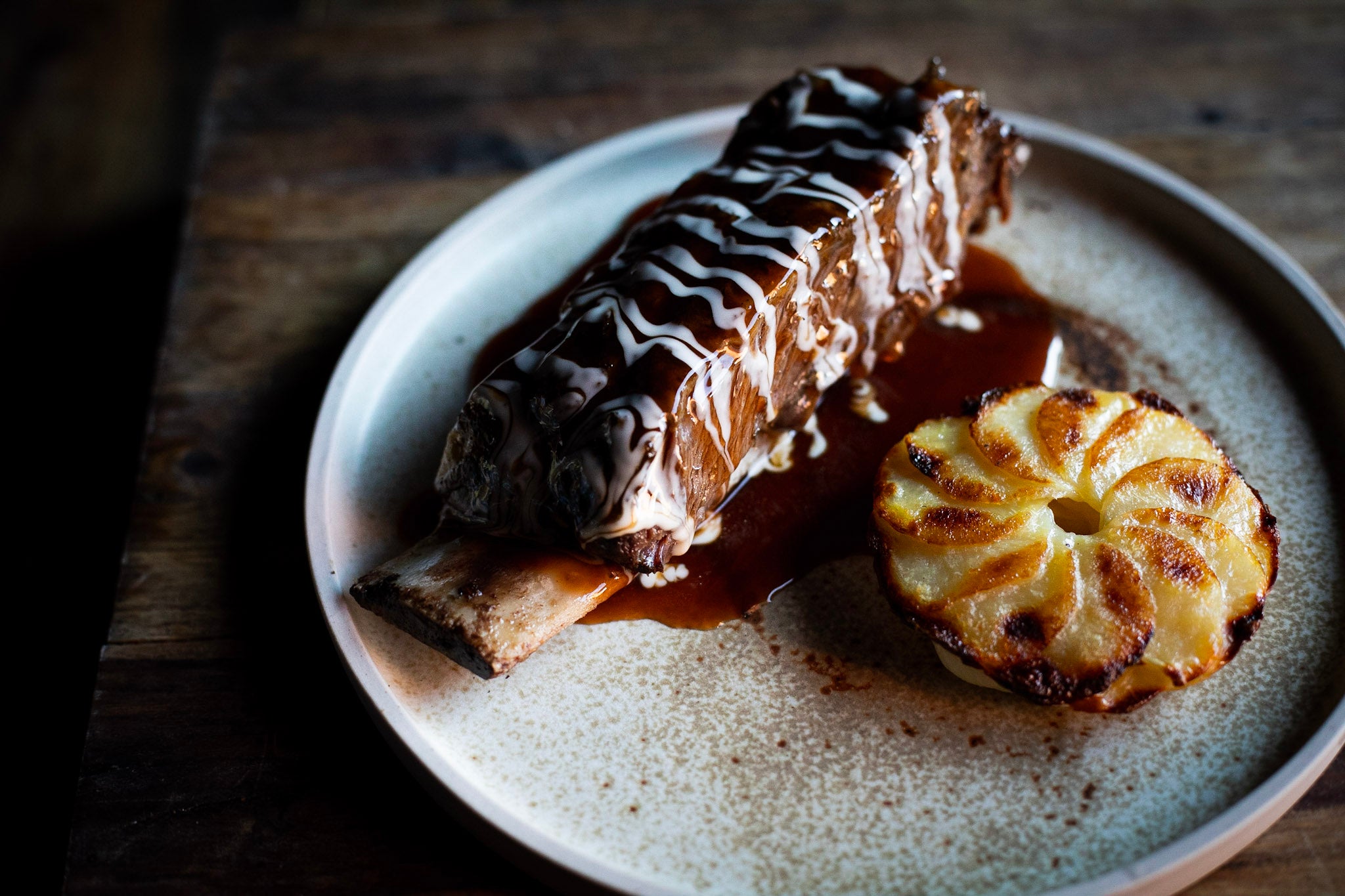
Take your barbecue to new heights with Fazenda’s recipe for melt-in-your-mouth beef short ribs with this easy technique. While cooking over open fire isn’t as common in the UK as it is back in South America, you can recreate the essence and flavours at home for the ultimate summer barbecue centrepiece.
Beef short ribs are often overlooked, though with the right care and expertise, they can easily become the star of the show. The key for optimum results is in the marinating and slow cooking to ensure the meat becomes succulent and tender.
For this recipe, you’ll need to use a home oven initially to slow cook your meat ahead of your garden gathering, finishing over your barbecue coals for a smoky finish.
Recipe by: Francisco Martinez, executive chef at Fazenda
Serves: 4
Ingredients:
2 kg beef short ribs (trimmed of excess fat)
50ml sunflower oil
1 tbsp salt
½ tbsp sugar
½ tbsp black pepper
½ tbsp smoked paprika
½ tbsp cumin
½ tbsp mixed dried herbs
Method:
1. Remove any excess fat by trimming your ribs to a 5mm fat cap, leaving just enough to add to the flavour.
2. Pour the sunflower oil onto the ribs and gently massage the meat to ensure even distribution.
3. Mix all the dry ingredients to make your dry rub marinade.
4. Coat the ribs all over with the dry rub.
Tip: For the next step, it’s important that you use a high-quality cling film to avoid the film melting during the cooking process. This will help contain the flavourful juices and moisture in the parcel, and is a suitable home method to replicate “sous-vide” cooking (as we would use at Fazenda).
5. Generously wrap the ribs in cling film, wrapping at least three or four times, then wrap with foil.
6. Roast at 100C for 8 hours overnight. Once removed from the oven, leave your ribs to cool to room temperature for a couple of hours before placing in the fridge until barbecuing time.
7. Place your ribs on the barbecue for one hour, still wrapped.
8. Remove the wrapping and place back on the coals or wood charcoal for a caramelised finish with smoky aromas before slicing and serving with sides of your choice.
Spicy fish skewers
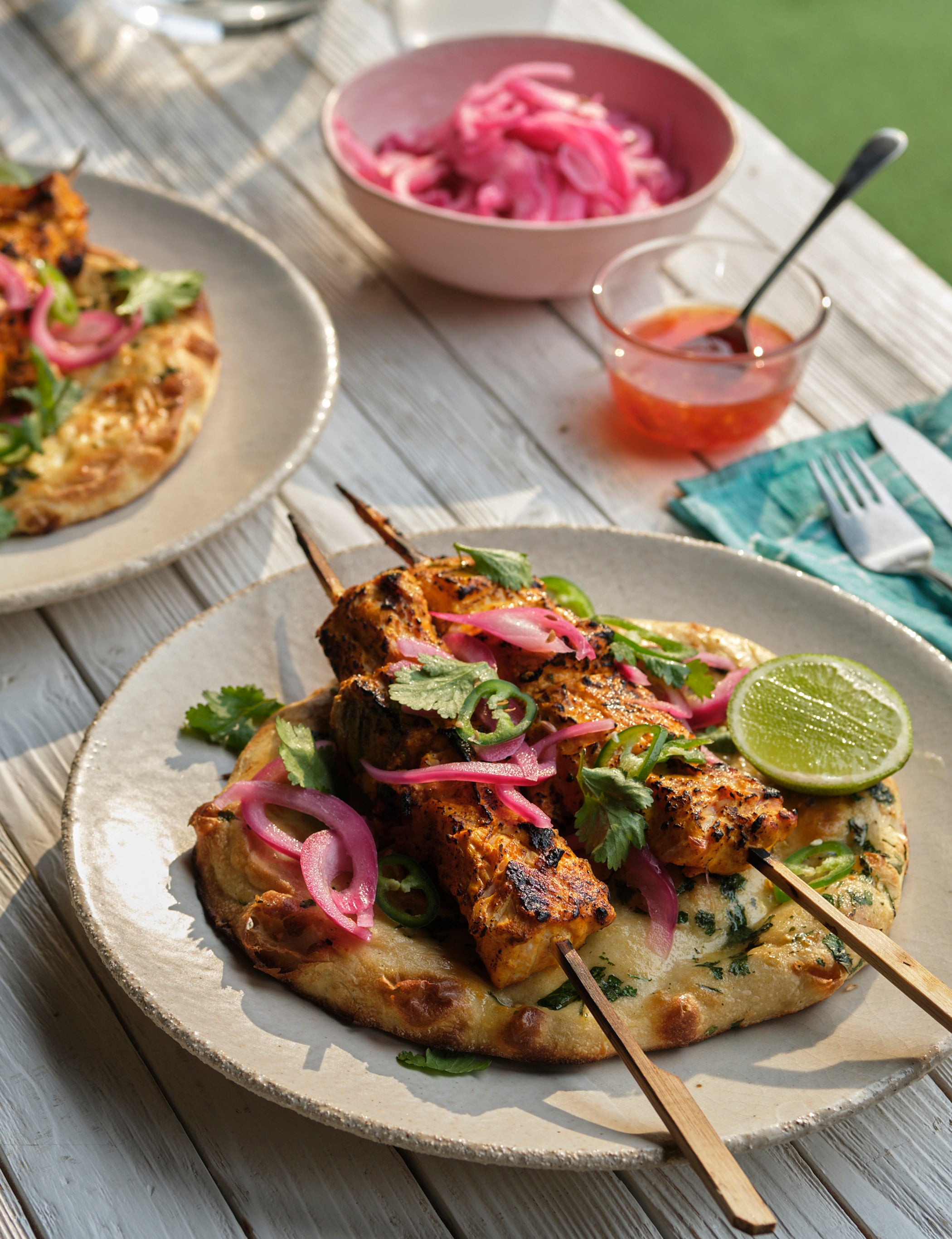
Perfect for pescatarians, these barbecued spiced salmon skewers are served with naan bread and pickled onions. Marinated in a mix of spices, these Asian-inspired salmon skewers are best cooked on a barbecue.
Makes: 8 servings
Ingredients
8 skinless salmon fillets (about 125g each)
2 large garlic cloves, grated
2.5cm piece of fresh ginger, grated
Juice of 1 lime
200g Greek yoghurt
1 tsp Kashmiri chilli powder
1 tsp ground turmeric
1 tsp ground cumin
2 tsp ground coriander
2 tsp sweet smoked paprika
Salt and freshly ground black pepper
For the pickled red onions:
2 small red onions
125ml water
125ml white wine vinegar
½ tsp fennel seeds
½ tsp cumin seeds
1 tbsp salt
2 tbsp sugar
To serve:
Naan bread or roti
A handful of coriander leaves
1 long green chilli, finely sliced
Lime halves
Sweet chilli sauce
Method
1. Prepare your pickled red onions an hour or so ahead. Thickly slice the onions and place in a clean jar. Put the water, wine vinegar, fennel and cumin seeds, salt and sugar into a small pan over a medium heat and stir until the sugar and salt are fully dissolved. Pour the hot pickling liquor over the onions and leave to cool slightly. Pop the lid on and place in the fridge to pickle.
2. To prepare the salmon, cut each fillet into four equal-sized chunks. Place these in a bowl with the garlic, ginger and lime juice and mix well.
3. In another bowl, mix the yoghurt with the spices and some salt and pepper. Add this spiced yoghurt to the salmon and mix well again. Leave to marinate in a cool place for at least 20 minutes, or up to an hour. Meanwhile, if using wooden skewers, soak eight, 16cm-long, in water for 30 minutes.
4. Once marinated, thread the salmon onto your skewers, putting four chunks onto each skewer.
5. Place the skewers on the hot barbecue and cook for two to three minutes on each side until golden brown and lightly charred. Meanwhile, warm the roti or naan on the edge of the barbecue. Once cooked, transfer the skewers to a warm plate.
6. Serve the skewers on the warm naan or rotis. Scatter over a little pickled red onion, some coriander and sliced green chilli. Serve with lime halves for squeezing over, and sweet chilli sauce on the side.
Grilled lamb cutlets with asparagus, horseradish and salsa verde
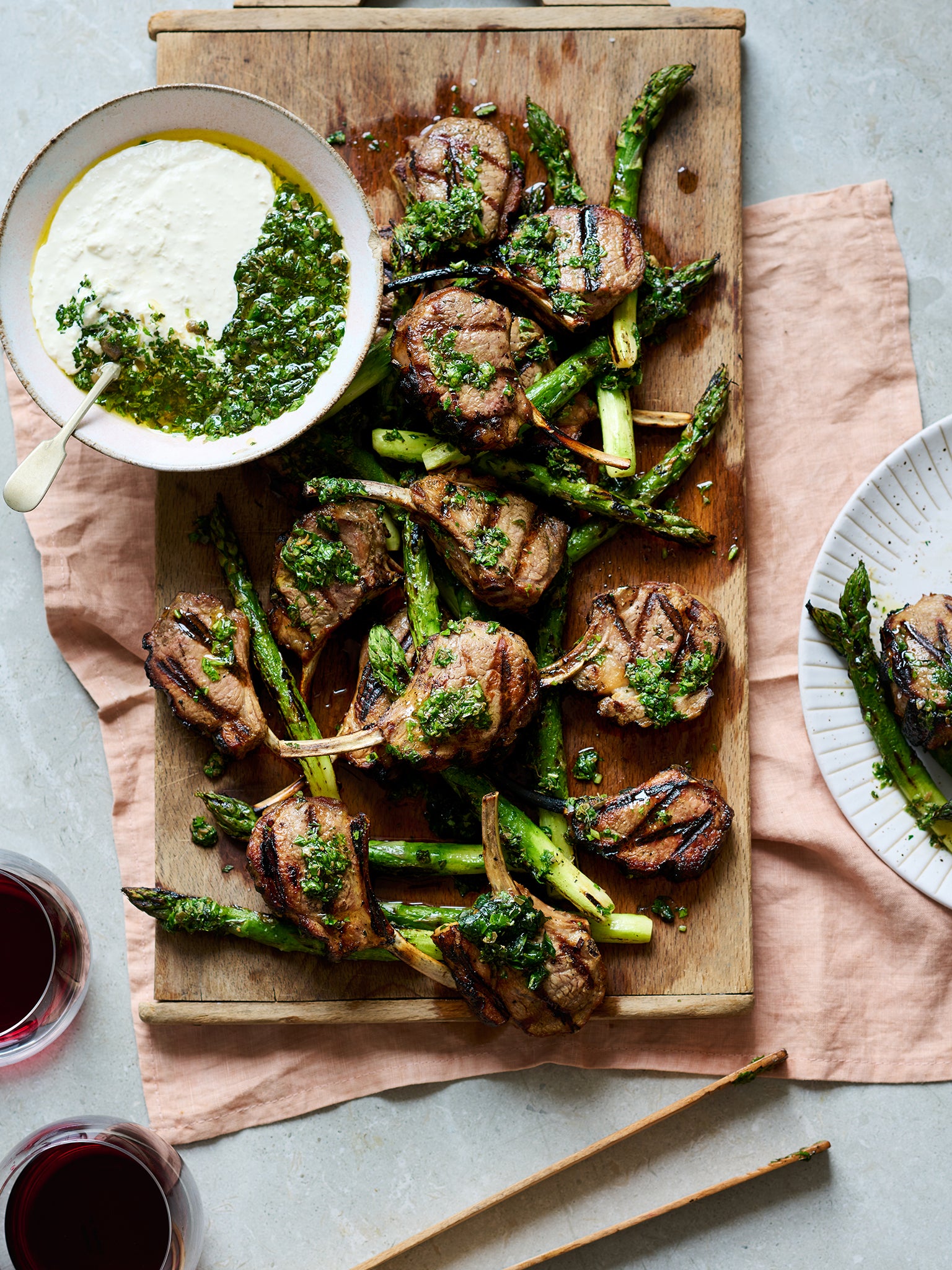
Little lamb cutlets are delicious griddled or barbecued because they are packed with flavour. Here they’re served with asparagus that can also be griddled over the coals. All the preparation can be done ahead and then it’s just a few minutes on the barbecue to create a stunning dish.
Makes: 4 servings
Ingredients
12-16 little lamb cutlets
Extra virgin olive oil
½ lemon
Sea salt and freshly ground black pepper
12 asparagus spears
For the salsa verde:
1 tsp toasted, ground cumin seeds
Bunch mint, leaves only
Bunch basil, leaves only
Bunch flat leaf parsley, leaves only
Bunch rocket
½ tbsp dijon mustard
2 anchovies
½ tbsp capers
1 clove garlic, peeled and chopped
2 tbsp red wine vinegar
200ml extra virgin olive oil
For the horseradish cream:
2in fresh horseradish root, grated
1 tbsp of red wine vinegar
Pinch sea salt
180ml of creme fraîche
Method:
1. To make the salsa verde, place all the ingredients except the olive oil in a food processor. Pour in the oil slowly through the funnel at the top. You should have a sludgy, vibrant green sauce. Set aside until ready to use.
2. To make the horseradish cream, place the grated horseradish into a bowl and pour over the red wine vinegar. Season with salt. Stir in the creme fraiche and place in the fridge until ready to use. Place a large pot of well-salted water and bring to a boil. Trim the woody ends of the asparagus.
3. To make the lamb, lay the lamb cutlets on a board. Season generously with salt and freshly ground black pepper and brush with oil. Heat the barbecue or a griddle pan until smoking, and cook the cutlets 1-2 mins per side.
4. While the cutlets are cooking, blanch the asparagus by dropping it into the boiling, well-salted water. Cook for 40 seconds – it should still have a nice bite. Alternatively, griddle on the barbecue alongside the meat. Remove the cutlets from the grill and squeeze over the lemon juice. Let rest for a few minutes to allow the meat to relax.
Coal-roasted aubergine with red miso, feta and toasted cashews
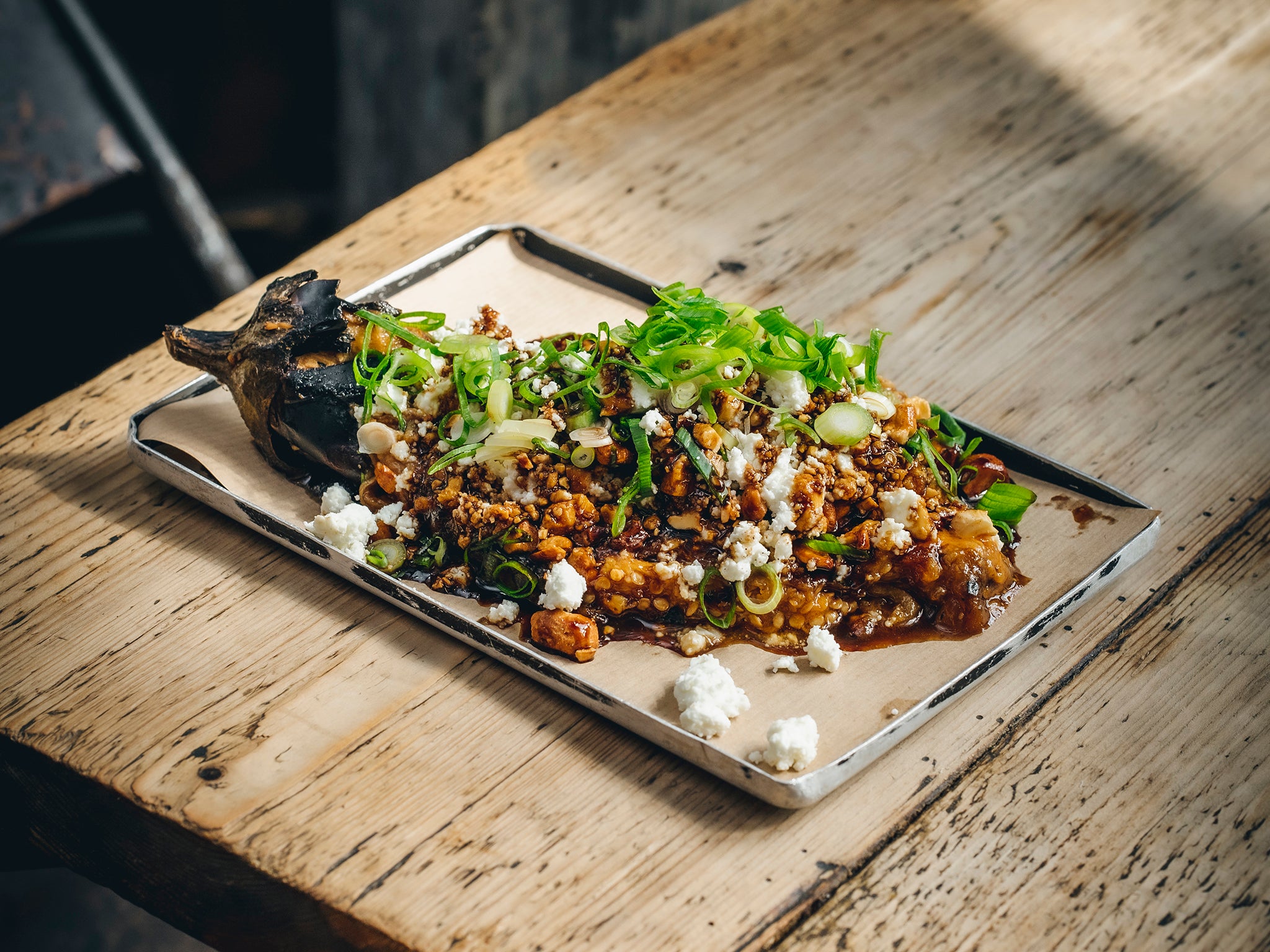
Recipe by: Smokestak
Serves: 1-2
Ingredients:
1 aubergine
40g feta
15g cashews
1 tbsp balsamic reduction
½ chopped spring onion
For the red miso butter:
150g butter, softened
50g red miso paste
15ml mirin (or, failing that, 15g caster sugar)
20g gochujang
5ml rice vinegar
For the marinade:
25g minced garlic
20g grated fresh ginger
25ml dark soy sauce
50ml light soy sauce
100g runny honey
Method:
1. In a bowl, mix all the marinade ingredients and set to one side.
2. Barbecue the aubergine directly over burning coals for five minutes, then rotate it 180 degrees and cook for five minutes more. Once the aubergine is soft to the touch all over, transfer to a board and leave to cool – avoid fiddling with it, or you’ll damage the skin and/or make the flesh go all mushy.
3. Once the aubergine is cool, peel off and discard the skin, then put the whole peeled aubergine into the marinade and leave to soak for at least four hours, and ideally for eight hours or overnight. (While it’s marinating, the aubergine will release juices into the saline marinade, which is important. If you prefer a less punchy marinade, loosen it with 125ml or so of water first.)
4. In a bowl, combine the softened butter with the miso, mirin, gochujang and rice vinegar.
5. On a low heat, toast the cashews in a pan with the tablespoon of butter until golden brown, then tip out on to a plate lined with kitchen paper to drain.
6. Now to finish off. Lift the aubergine from its marinade, put it in a roasting tin, then spread liberally with the miso butter. Barbecue with the lid down – or roast in a 200C/180C fan/390F/gas 6 – for 10 minutes, until hot all the way through, then transfer to a plate. Crumble over the feta, top with the toasted cashews, balsamic reduction and spring onion, and serve.
Oregano-poached peaches, halloumi and hazelnuts
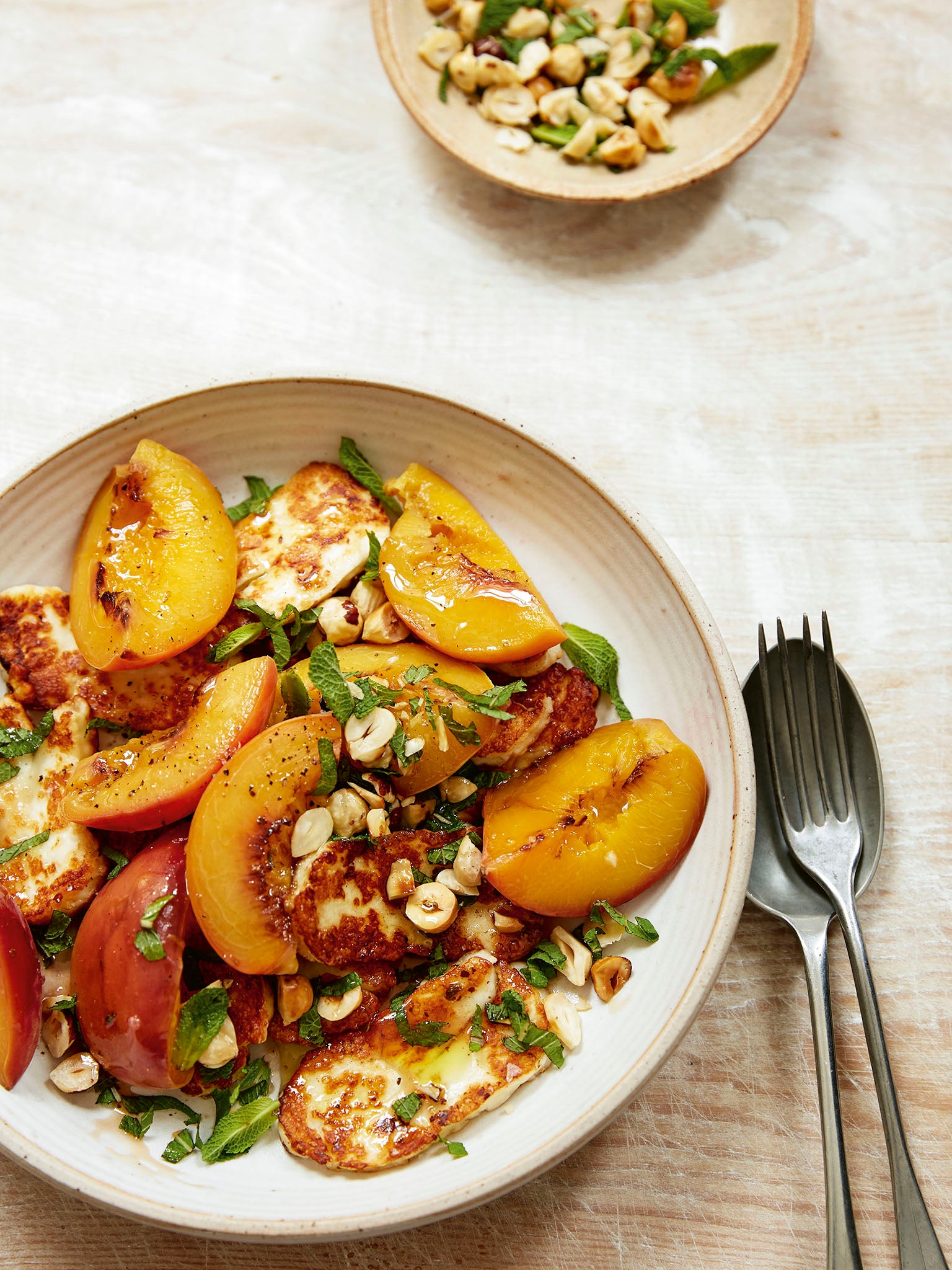
There are fresh herbs, there are dried herbs, and then there are frankly incredible dried herbs. Into that last camp fall dried herbs that are produced to exceptionally high standards and don’t just harness the flavour of the starting point, but elevate it. Those are the only dried herbs really worth having in your store cupboard.
This recipe goes for poaching fresh peaches with dried oregano, which brings even more depth of flavour than fresh oregano would. Given the choice, I use one of the beautiful dried sprigs at Oliveology, but their ground oregano is lovely too. The poaching liquor is then reduced to a fragrantly sweet syrup for pouring over tender peach slices and fried halloumi, and finished with seasoned toasted nuts and mint. Perfect for a hot day.
Recipe by: Angela Clutton, Borough Market
Serves: 2 as a main, 4 as a side or small plate
Ingredients:
2 tsp dried oregano (or an Oliveology dried sprig)
1 tbsp honey
1 orange
2 peaches
40g skinned whole hazelnuts
1 tbsp fruity olive oil
6 sprigs of mint
225g halloumi
Method:
1. Pour 500ml water into a medium saucepan. Add the dried oregano (or oregano dried sprig), the honey and two broad strips of zest from the orange. Bring to the boil and, meanwhile, quarter and stone the peaches. Put them into the water, lower the heat to a simmer and sit a piece of baking paper on top. Simmer for 7-10 minutes until the peaches are fully tender. Use a slotted spoon to lift the peaches out and set aside. If their skins start to flake away as they cool, just peel them off.
2. Strain the poaching liquor, discard the oregano and orange peel, then pour the poaching liquor back into the saucepan. Don’t worry if a few pieces of oregano are left in the liquid. Boil over a high heat for 10-15 minutes to reduce to a syrup – you are aiming for about 75ml syrup.
3. While the poaching liquor reduces, toss the hazelnuts in the olive oil along with some salt flakes and freshly ground black pepper. Set a small dry frying pan over a low heat, then add the seasoned nuts and stir for 3 minutes or until they are just getting nicely toasted. Transfer to a bowl. Once they have cooled, roughly chop with the leaves from the mint sprigs. Cut the poached peach quarters into slices about 1cm thick.
4. Once the syrup is almost sufficiently reduced, cut the halloumi into 1cm-thick slices. Set the same frying pan the nuts were cooked in back onto the heat, then add the halloumi pieces, turning each over after 2 minutes or so once they are browned. You might need to do this in two batches.
5. Serve either on individual plates or on a large platter. Sit the halloumi on first, then arrange the peach slices prettily on top, scatter over the seasoned nut and mint mixture, and finish by spooning over your oregano-infused peach syrup.
Niçoise bundles
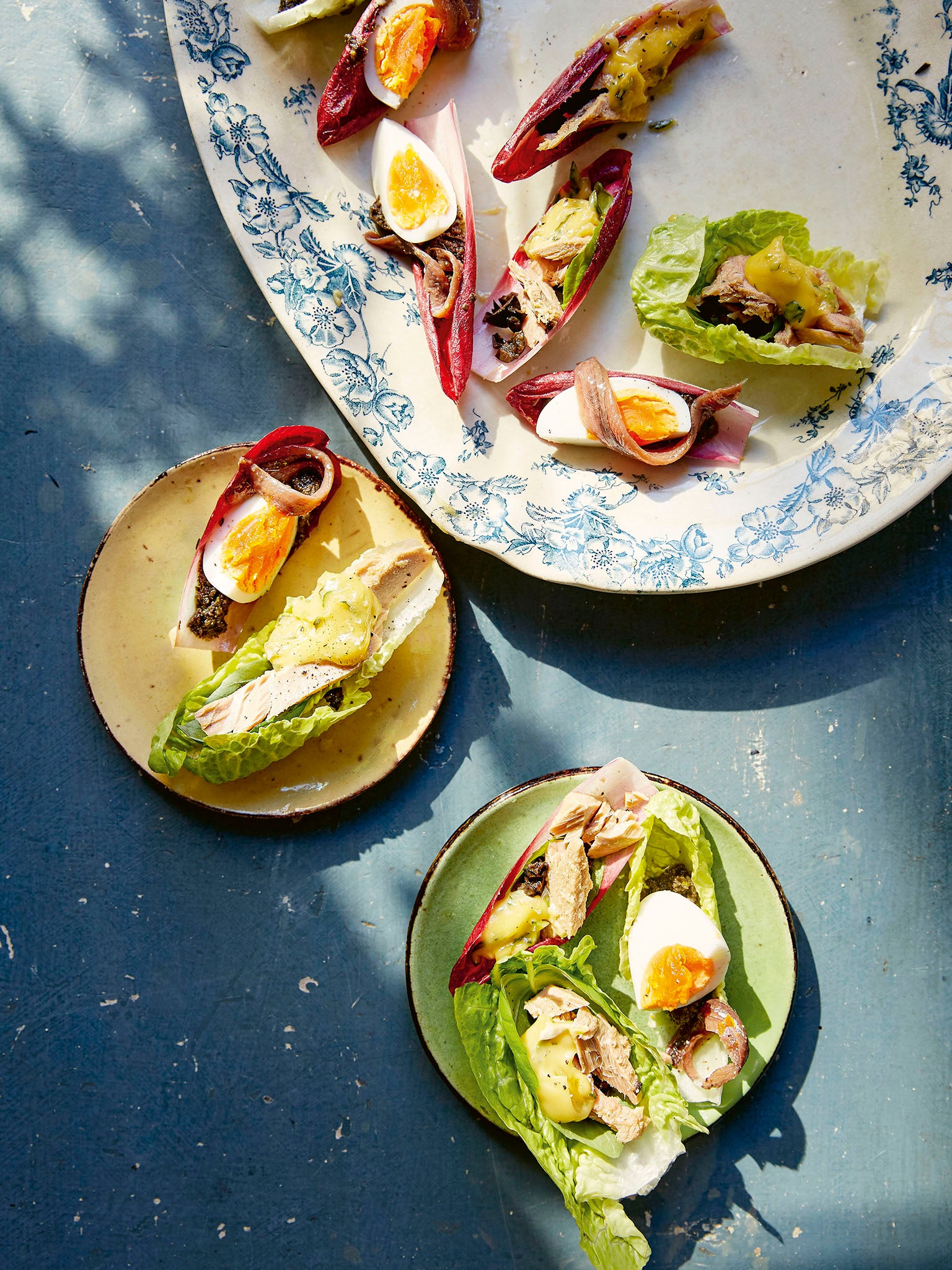
The classic niçoise salad is served here as individual bundles that are perfect for a summer lunch or starter. I’m giving you two versions: one layers up blitzed olives and capers with egg and an anchovy; for the other, flaked tuna sits on an olive bed with tarragon mayo. Their simplicity makes it important that each ingredient is chosen for maximum flavour.
Perhaps especially the fish. I make these with (my favourite) Brindisa Ortiz anchovies and the same maker’s yellowfin tuna belly ventresca, which in one bite of its long, tenderly rich hakes took me from thinking I didn’t really like tinned tuna to stockpiling it.
Recipe from: Angela Clutton, Borough Market
Serves: 4 as a main or 8 as a small plate or starter
Ingredients:
16 leaves of little gem lettuce and/or red chicory
For the tarragon mayonnaise:
1 egg yolk, at room temperature
1½ tsp moscatel wine vinegar
¼ tsp English mustard powder
100ml sunflower oil
50ml mild olive oil
1 sprig of tarragon
For the olive and tuna mix:
½ tsp raspberry vinegar
8 basil leaves
100g pitted black olives, drained weight
110g tinned yellowfin tuna
For the egg, olive and anchovy mix:
2 hen’s eggs or 4 quail’s eggs
150g pitted black olives
2 tsp capers
1 garlic clove
7ml peppery olive oil, plus 1 tbsp for drizzling
½ lemon
8 anchovy fillets
Method:
1. Wash and dry the lettuce or red chicory leaves.
2. Make the mayonnaise by gently hand-whisking the egg yolk with a pinch each of salt and ground pepper. Stir in the vinegar and the mustard powder, then hand-whisk in both the oils – drop by drop to start with, then in a steady, thin stream – until you have a lovely thick, shiny mayonnaise. Check the seasoning, chop the tarragon leaves and stir through.
3. Sprinkle a little raspberry vinegar, salt and pepper inside eight of the little gem/chicory leaves and line with a basil leaf. Chop the olives and sit them inside. Top with flaked tuna. Serve with the tarragon mayonnaise on top, or alongside to be spooned over.
For the other half of the leaves:
1. Hard-boil the eggs and set aside to cool.
2. Put the olives, drained capers, peeled garlic, 75ml of olive oil and a good squeeze of lemon juice in a blender and blitz to a paste.
3. Peel the hard-boiled eggs. Quarter them if hen’s, halve if quail’s. Spoon the olive relish inside the lettuce/chicory leaves, sit a piece of egg inside too and then over the top the whole anchovy fillet. Drizzle with the remaining olive oil.
4. Serve the bundles on platters for people to help themselves, or portion up two of each type per person.
Asparagus, basil and pea salad with burrata
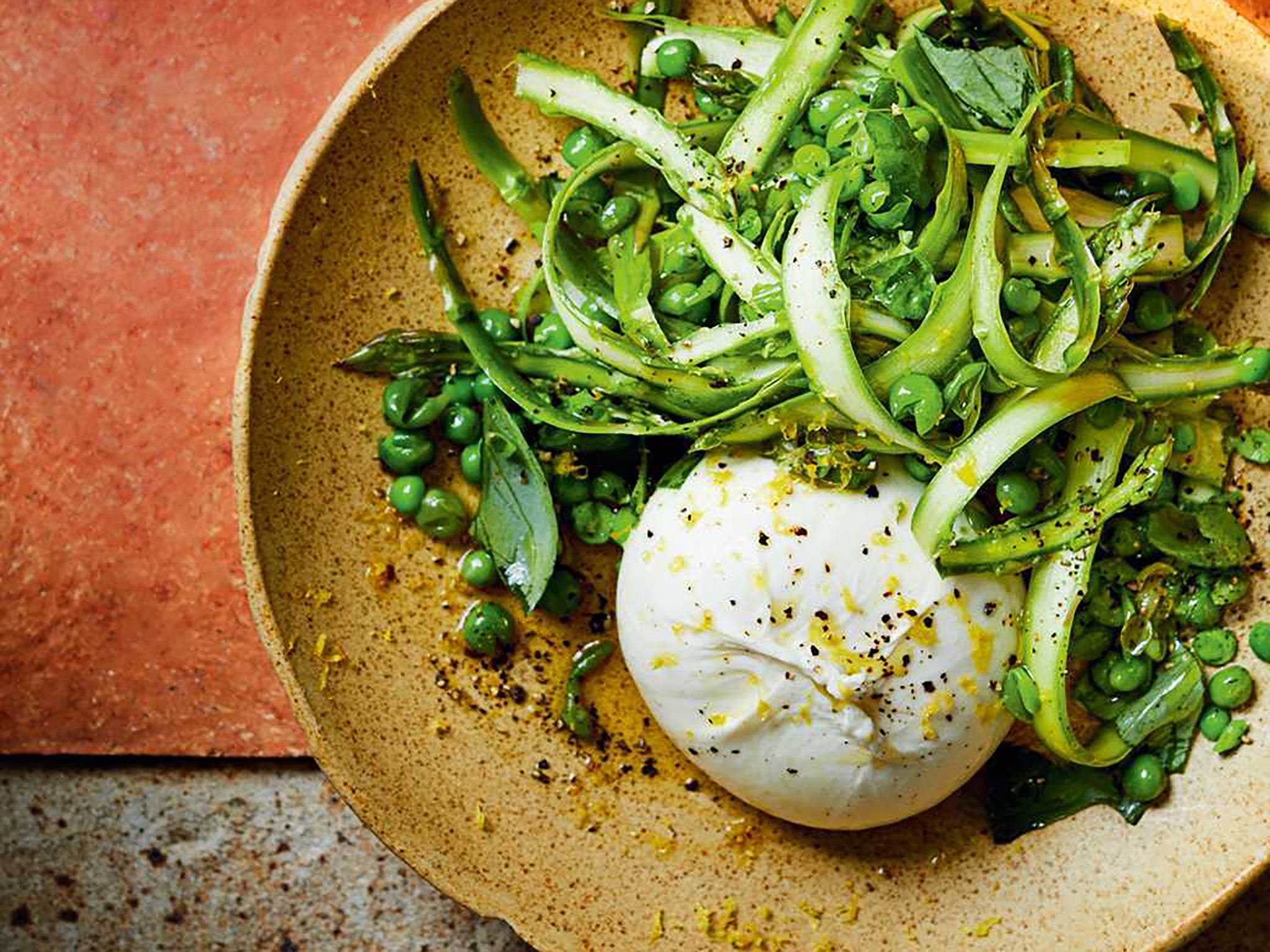
This asparagus, basil and pea salad with burrata is great as an easy starter. Perfect for BBQ season, simply bump up the quantities and serve on a platter for everyone to dig in if you’re feeding a bigger crowd.
British asparagus is currently in season (April-July), so it’s the perfect time to make this recipe! It’s also high in fibre and a rich source of folate, which supports the immune system and plays a role in the normal formation of blood.
Recipe by: Olivia Cavalli for Ocado
Serves: 2
Ingredients:
100g fresh or frozen peas, defrosted
2 tbsp extra-virgin olive oil, plus extra to serve
½ lemon, finely zested, plus a squeeze of juice
50g Ocado aine asparagus spears, woody ends trimmed and spears shaved into thin ribbons with a vegetable peeler
1 handful basil leaves, torn
1 pinch sea salt flakes, plus extra to serve
150g burrata (vegetarian if required)
Method:
1. Bring a small pan of water to the boil, add the peas and cook for 1-2 mins until bright green. Drain and transfer to a mixing bowl.
2. Use a potato masher to lightly crush the peas. Add the oil, lemon zest and juice, asparagus ribbons and basil. Season with sea salt flakes and toss so everything is well coated.
3. To serve, place the burrata on a plate and season with sea salt and freshly ground black pepper. Add the pea and asparagus mixture and finish with a drizzle of oil.
Baked ricotta cheesecake with rosemary tomatoes
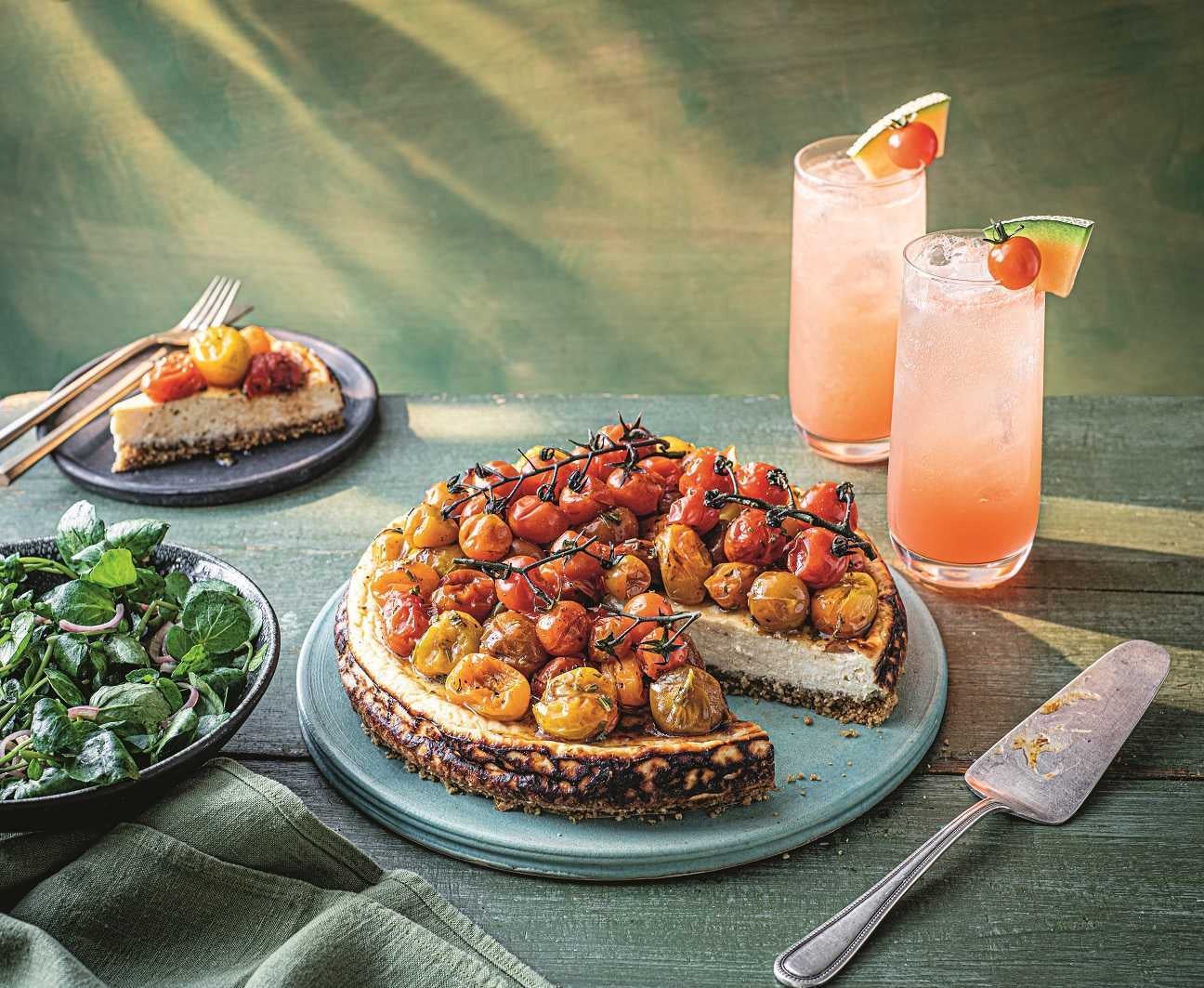
A savoury showstopper with a twist – this one is sure to impress your guests. The fresh, sweet tomatoes balance perfectly with the salty cheese and nutty base – a true crowd pleaser. Sweet and nutritious (and perfectly in season from June-October), cherry tomatoes are a source of vitamin C, which plays a role in the normal formation of collagen and normal function of blood vessels, bone, cartilage, gums, skin and teeth.
Serves: 8
Ingredients:
100g unsalted butter, melted, plus extra for the tin
150g oatcakes
50g digestive biscuits
30g walnuts
550g assorted Isle of Wight cherry vine tomatoes
1½ tbsp balsamic vinegar
3 tbsp olive oil
1 tbsp chopped rosemary
2 garlic cloves, chopped or grated
1 tsp soft brown sugar
2 (250g) tubs ricotta
150g cream cheese
4 large eggs
80g parmesan, finely grated
160g watercress
1 small echalion shallot, sliced
Method:
1. Preheat the oven to 180C/160C fan/gas 6. Grease a 24 cm round springform tin with butter. Blitz the oatcakes, digestives and walnuts in a food processor to coarse crumbs; stir in the butter. Press evenly into the tin base and a little up the sides. Chill for at least 30 minutes.
2. Toss the tomatoes in a roasting tin with 1 tbsp balsamic vinegar, 2 tbsp olive oil, the rosemary, garlic and sugar; season. Roast for 25-30 mins to soften; set aside to cool.
3. Reduce the oven temperature to 160C/140C fan/gas 3. Put the ricotta, cream cheese, eggs and parmesan into a bowl with a pinch of salt; mix until smooth. Spoon into the base. Bake for 40-45 mins.
4. Meanwhile, put the watercress and shallot in a bowl and toss with the remaining 1 tbsp olive oil and ½ tbsp balsamic vinegar; season.
5. Remove the cheesecake from the oven; leave to stand in the tin for 5 mins. Transfer to a plate (on the tin base); arrange the tomatoes on top. Serve warm or cold, with the salad.

Join our commenting forum
Join thought-provoking conversations, follow other Independent readers and see their replies
Comments